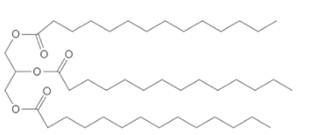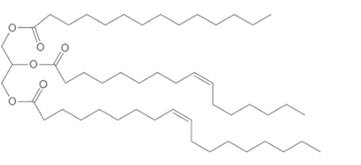
Concept explainers
(a)
Interpretation:
The products of hydrolysis of given triacylglycerol needs to be determined.

Concept Introduction:
Lipids are
Triacylglycerols are most abundant lipids which are mainly found in animal fat and vegetable oils. They are triesters of glycerol, therefore in the formation of one molecule of triacylglycerol, three molecules of fatty acids react with one molecule of glycerol as given below;
(b)
Interpretation:
The products of hydrolysis of given triacylglycerol needs to be determined.

Concept Introduction:
Lipids are biomolecules which are involved in different biochemical reactions. They are special types of organic molecules which can only identify with the help of their physical properties, not by the presence of any certain functional group. In general, lipids contain a large number of C-C and C-H bonds with few polar functional groups such as
Triacylglycerols are most abundant lipids which are mainly found in animal fat and vegetable oils. They are triesters of glycerol, therefore in the formation of one molecule of triacylglycerol, three molecules of fatty acids react with one molecule of glycerol as given below;
Want to see the full answer?
Check out a sample textbook solution
Chapter 19 Solutions
General, Organic, and Biological Chemistry - 4th edition
- Explain what a β-1,4-glycosidic bond is made up of? (ie. Breakdown how a bond is considered a β-1,4-glycosidic bond?arrow_forwardWomen may be affected more by alcohol than men due to __________.A.having a lower proportion of water than menB.reduced levels of enzymes that break down alcohol in the liverC.having a lower fat-to-muscle ratio than menD.both A and Barrow_forwardWhat products are formed by hydrolysis of each lactone or lactam withacid?arrow_forward
- Draw the structure of the aldehyde synthesized from ethanol inthe liver.arrow_forwardTrue or False a. Stearic acid is an unsaturated fatty acid.b. Human fat has more unsaturated fatty acids than plant fats.c. Soaps and detergents form micelles when added to water.d. Soap micelles form in water by aggregating the negatively charged carboxylategroups toward the inside and the lipophilic carbon chains toward the outside of themicelle.e. The forces that drive micelle and lipid bilayer formation are the same.f. There are several stereoisomers of cholesterol found in living systems.g. Aldosterone is an androgen.h. Vitamin D precursors have the cholesterol ring system.i. Vitamin E is required for blood clotting.j. Prostaglandins are involved with the inflammatory response.arrow_forwardf) why is significant serum (in the bloodstream) cholesterol reduction so difficult, and why do most of the drugs designed to reduce cholesterol target the liver?arrow_forward
- EPA (eicosapentaenoic acid) and DHA (docosahexaenoic acid) are made from A. linoleic acid B. Oleic acid C. linolenic acid D. Stearic acidarrow_forwardDraw a triacylglycerol made from glycerol, myristic acid, palmitic acid, and oleic acid. Place palmitic acid at the middle position.arrow_forwardDraw the products formed when triacylglycerol A is treated with each reagent. Rank compounds A, B, and C in order of increasing melting point.a. H2O, H+b. H2 (excess), Pd-C → Bc. H2(1 equiv), Pd-C → Carrow_forward
- Draw the reaction of glycerol and the two fatty acids to create sunflower seed oilarrow_forward1. Draw the structure of a triacylglycerol formed from glycerol, one molecule of stearic acid, and two molecules of oleic acid. The stearic acid should form an ester bond with the 2° OH group of glycerolarrow_forwardDraw a structure for the ethyl acetoacetate :arrow_forward

 Introduction to General, Organic and BiochemistryChemistryISBN:9781285869759Author:Frederick A. Bettelheim, William H. Brown, Mary K. Campbell, Shawn O. Farrell, Omar TorresPublisher:Cengage Learning
Introduction to General, Organic and BiochemistryChemistryISBN:9781285869759Author:Frederick A. Bettelheim, William H. Brown, Mary K. Campbell, Shawn O. Farrell, Omar TorresPublisher:Cengage Learning

